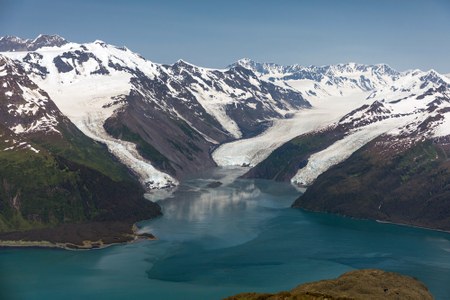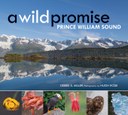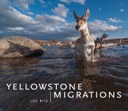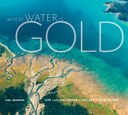
EXCERPTED FROM A WILD PROMISE, PUBLISHED BY BRAIDED RIVER
“We need a book. But first you need to see this place.” So began my conversation with Debbie Miller and Hugh Rose in a bar in Fairbanks on my first day back to civilization after an all-too-brief rafting trip in the Arctic National Wildlife Refuge. Debbie, Hugh, and I had collaborated before. Through numerous past publishing and outreach efforts we had strived to prevent oil drilling in America’s Arctic. This time our discussions revolved around 2.1 million acres of the Chugach National Forest in southwestern Alaska proposed as a wilderness study area. This stemmed from the Alaska National Interest Lands Conservation Act (ANILCA) passed in 1980, the largest lands conservation act in U.S. history and the law that has defined much of Alaska’s public lands debates. The fate of this wilderness study area established in 1980 was expected to be resolved in a few years, yet it is still in limbo decades later.
Even before ANILCA, locally and nationally, many citizens had long supported wilderness protection in western Prince William Sound, and this effort has been sustained over generations. Voices for wilderness include commercial and sport fishers who rely on healthy fisheries, subsistence and sport hunters and guides who rely on abundant wildlife, and business owners who cater to outdoor recreation and tourism. Local residents and families rely on the region’s wealth of wild foods, including berries, mushrooms, and fish. Ancient rainforests keep carbon out of the atmosphere and serve as magical places to bring friends, raise a family, and expose children to the magic and wonders of the natural world.
The path toward wilderness designation and protection was complicated by the horrific disaster on March 24, 1989, when the Exxon Valdez careened off course, split open, and spilled eleven million gallons of oil into the pristine waters of Prince William Sound -- killing thousands of mammals and sea birds and coating and spoiling untold miles of land and sea. The disaster and subsequent cleanup efforts compromised the wilderness character of the area.
The public response has been clear and consistent: protect this area by designating it as wilderness. What will this take? Literally an act of Congress.
Debbie, Hugh, and I determined that we would do what we could to tell the story of this extraordinary place and to support grassroots efforts to achieve the wilderness designation crucial to its preservation. One week later, I was aboard the Discovery, a sixty-five-foot vessel built in the 1950s, nimbly making its way amid the astonishing splendor of massive glaciers and deeply forested islands of Prince William Sound’s interior passages. This was my introduction to the Nellie Juan–College Fiord Wilderness Study Area.
As is so often the case with dwindling wild public land, the Nellie Juan -- located along the western edge of Prince William Sound -- is remote, achingly pristine, largely unheard of, and in the crosshairs of those who rather bloodlessly refer to “resource extraction potential.” In other words, it is a target for short-term exploitation and ruin. Our mission on this voyage was to discuss how we could express the magnificence all around us and how a book could play a role in engaging the region’s inhabitants and all Americans. Could we inspire deep discussions about the fate of this public land and the fate of our own human communities in the region? Through a book we would strive to bring the Nellie Juan into sharper focus.
I believed that Hugh’s sensitive and in-depth catalog of images would convey the abundance of life, the timelessness of seasons, and vastness of land. And I was confident that Debbie would translate her rich experiences exploring these remote landscapes into vivid, engaging prose. What I was not prepared for was a lesson from Dean Rand, captain of the Discovery, and his importance to the telling of this story.
Dean epitomized not only time-earned knowledge of the life and land of Prince William Sound but also wisdom. His resolve, tenacity, and love of place were almost tangible. He was worried about what might happen if people were not aware of what was at stake and did not weigh in, and he saw that this landscape in limbo could flip from wild to domesticated -- and damaged -- with the stroke of a pen. As I sat in his compact wheelhouse, we talked as he guided us to glaciers and islands, bays, coves, and deep fjords lined with rookeries, where we would see splendid mountains, wildflowers, and waterfalls and meet oyster farmers and commercial fishers. And the word displaced came to mind. If development ran rampant and unchecked, it was not only whales, puffins, salmon, bears, and sea otters who would struggle -- it was also Dean and his family and human community who would become unmoored, without ground, homeless.
Dean was wholly committed and made me believe that one person can make a difference. Through his own initiative, he was making connections and opening up opportunities for political engagement, for himself and for others. Grassroots activism at its best. This region was once encased in ice, and it has responded to the ever-changing whims that alter the natural cycles of life over and over again. This is a place too precious to exploit. If we can leave this wilderness area as is, it will serve as a source of wonder, solace, food, and community for future generations of Alaskans and for visitors from around the globe. Sharing this special place shapes our lives, but it also unites us.
I hope that we have successfully conveyed a sense of the Nellie Juan–College Fiord Wilderness Study Area. I hope too that we have shown how important it is for people -- for humanity -- to be connected strongly to wild rhythms and to a special wild place.
Another public comment period is coming up when Americans will have a chance to voice their opinions about the fate of Prince William Sound. Sign up for our enewsletter, and we’ll keep you in the loop.
 Helen Cherullo
Helen Cherullo


